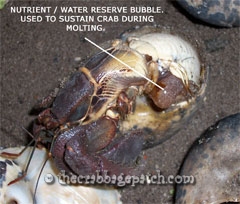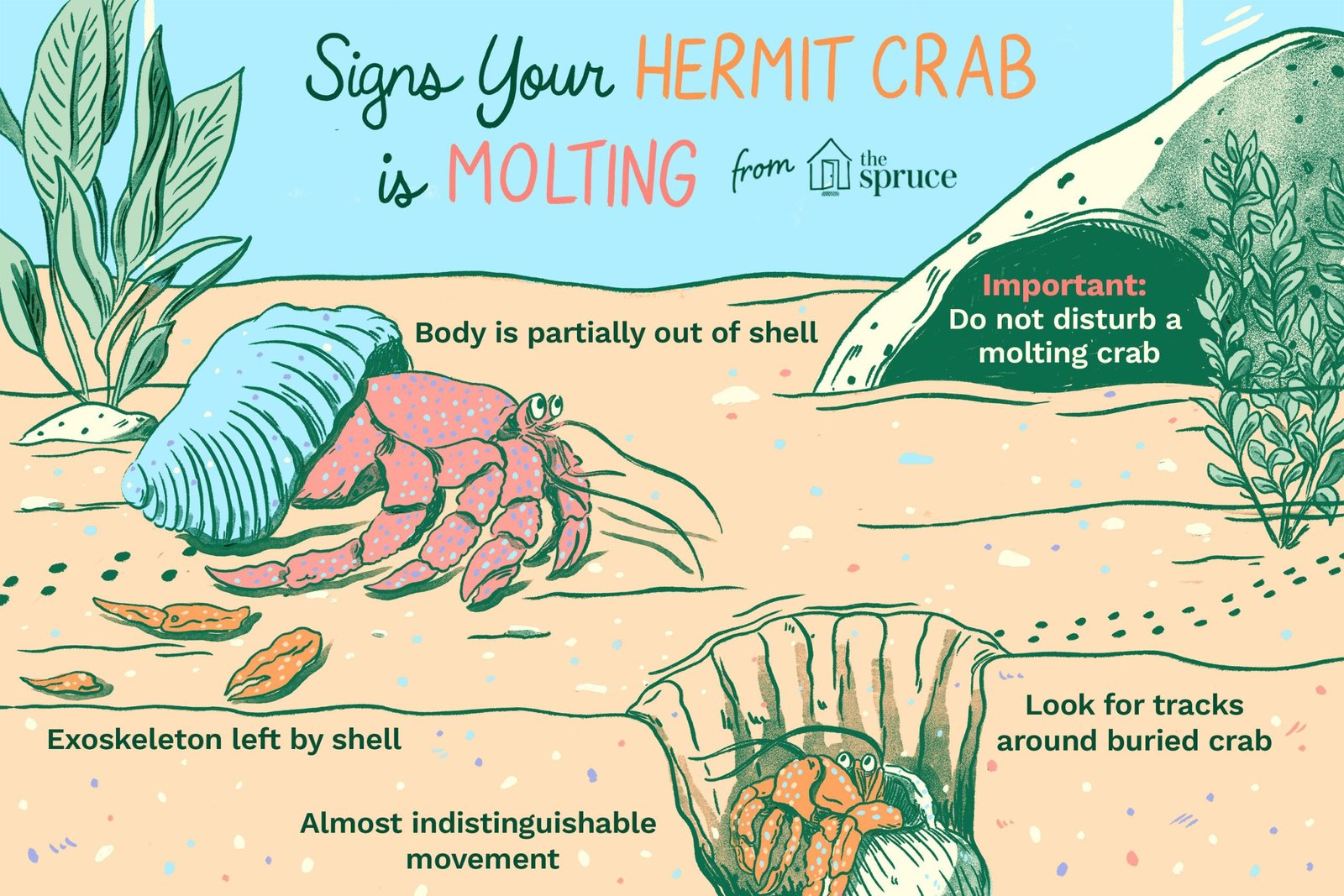Hermit crab molting signs include increased digging, eating and drinking, and a change in appearance after molting. These signs indicate that a hermit crab is preparing to molt and should be given the necessary care and attention during this process.
It is important to avoid disturbing a molting hermit crab, as it can be detrimental to their survival. When it comes to hermit crabs, molting is a vital process in their growth and development. Understanding the signs of molting is essential for providing proper care and ensuring the well-being of these fascinating creatures.
This article will explore the various signs that indicate a hermit crab is molting, including increased digging, eating, and drinking habits, as well as changes in their appearance after molting. By being aware of these signs, hermit crab owners can take appropriate measures to support their pets during this crucial stage.

Credit: crabstreetjournal.org
Understanding Hermit Crab Molting
Understanding hermit crab molting can be crucial for their well-being. By recognizing the signs of molting, such as increased digging behavior, brownish eyes, and a change in eating habits, you can ensure that your hermit crab receives the necessary care during this delicate process.
What Is Molting?
Understanding hermit crab molting is essential for every hermit crab owner. Molting is a natural process where hermit crabs shed their exoskeleton to grow. This incredible phenomenon allows them to renew their outer layer as they continue to grow bigger and stronger. Molting is necessary for hermit crabs to thrive and is a vital part of their life cycle. By understanding the signs and stages of molting, you’ll be able to provide the best care for your hermit crab during this crucial time.
The Molting Process
The molting process for hermit crabs is a complex and delicate procedure. It starts with the hermit crab burying itself in the substrate, creating a safe and secluded space to molt. During this time, the exoskeleton breaks and the crab exits the old shell. The crab then absorbs water, promoting the growth of its new exoskeleton, which gradually hardens. This process can take several weeks, depending on the size and age of the crab.
There are several signs to look out for during the molting process. Hermit crabs may appear dormant or become less active during this time. You may notice them digging and tunneling in their enclosure, preparing for the molt. Their eating behavior may also change, with some hermit crabs refusing food altogether. Brownish eyes are another common sign of impending molting, as the eyes become darker and less vibrant.
Post-molt Care
After molting, hermit crabs require special care to ensure a successful transition. The new exoskeleton is delicate and needs time to harden completely. During this time, it’s crucial to provide a quiet and stress-free environment for the crab. Avoid handling or disturbing the crab for at least a week to allow for a smooth post-molt recovery.
Post-molt care also includes monitoring the crab’s limb regeneration. It’s normal for hermit crabs to regenerate lost limbs during molt. Keep an eye on the regrowth progress and offer a variety of calcium-rich foods to support the development of new limbs.
Offering a calcium source, such as a cuttlebone or powdered calcium supplement, is essential for hermit crabs during and after molting. This will promote the development of a strong exoskeleton and help prevent common issues, such as shell rot or soft exoskeletons.
In conclusion, understanding hermit crab molting is crucial for every hermit crab owner. By recognizing the signs and stages of molting, you’ll be able to provide the appropriate care and create a safe environment for your crab during this vital process. Remember to always be patient and observant, ensuring your hermit crab has the best chance for a successful molt and continued growth.
:strip_icc()/close-up-of-hermit-crab-on-sand-at-beach-727139521-5af870f80e23d900379c975c.jpg)
Credit: www.thesprucepets.com
Signs Of Hermit Crab Molting
A hermit crab that starts digging more than usual is a clear sign that it is preparing to molt. This behavior indicates that the crab is getting ready to shed its exoskeleton and grow.
Hermit crabs are fascinating creatures known for their ability to molt, which is the process of shedding their exoskeleton in order to grow. Molting is a natural and necessary part of their life cycle, and there are several signs to look out for that indicate your hermit crab is molting. These signs include brownish eyes, changes in eating behavior, and isolating the hermit crab. Let’s explore each of these signs in more detail.
Brownish Eyes
A telltale sign that a hermit crab is preparing to molt is the appearance of brownish eyes. Prior to molting, a hermit crab’s eyes will turn a darker color, specifically brown. This change in eye color is due to the release of a pigment called melanin, which helps protect the crab’s eyes during the molting process. So, if you notice that your hermit crab’s eyes have turned brown, it’s a good indication that molting is imminent.
Changes In Eating Behavior
Another sign of hermit crab molting is changes in their eating behavior. As hermit crabs prepare to molt, they may start to eat less or even stop eating altogether. This decrease in appetite is natural and serves as a way for the crab to conserve energy for the molting process. So, if you notice that your hermit crab has suddenly become less interested in food or has stopped eating altogether, it’s likely that they are getting ready to molt.
Isolating The Hermit Crab
One of the most noticeable signs of hermit crab molting is their tendency to isolate themselves. During the molting process, hermit crabs seek out a safe and secluded spot where they can molt in peace. They may burrow into the substrate or hide in a cave, effectively isolating themselves from other crabs and the outside environment. So, if you see your hermit crab retreating to a hidden spot and spending an extended period of time there, it’s a strong indicator that they are molting.
Differentiating Molting From Death
Differentiating hermit crab molting signs from death can be challenging, but there are clues to look out for. Signs of molting include excessive digging, a change in appetite, and a soft exoskeleton, while signs of death may include a foul odor and a limp, lifeless body.
Limp Test
When it comes to differentiating molting from death in hermit crabs, one of the most effective methods is the Limp Test. This simple test involves gently picking up the crab and checking whether its limbs are flexible or stiff. If the limbs are limp and can be moved easily, it is a clear indication that the crab is molting. On the other hand, if the limbs are stiff and unresponsive, it suggests that the crab has passed away. It is important to handle the crab with care during the Limp Test to avoid causing harm or stress.Sniff Test
Another helpful way to determine whether a hermit crab is molting or deceased is through the Sniff Test. This test involves bringing the crab close to your nose and taking a gentle sniff. If you detect a mild, earthy smell, it usually means that the crab is molting. This scent is often associated with the process of shedding and regenerating their exoskeleton. However, if there is a strong foul odor or no smell at all, it is likely that the crab has passed away. It is important to handle the crab carefully and not to inhale deeply during the Sniff Test to avoid any unpleasant experiences.Remember, when it comes to determining whether a hermit crab is molting or deceased, the Limp Test and Sniff Test can be useful indicators. However, it is essential to take other factors into consideration as well, such as the crab’s behavior, appearance, and overall health. If you are unsure about the status of your crab, it is always recommended to seek advice from a veterinarian or a knowledgeable hermit crab enthusiast.

Credit: www.hermitcrabpatch.com
Frequently Asked Questions For Hermit Crab Molting Signs
How Do I Know If Hermit Crab Is Molting?
To know if a hermit crab is molting, watch for signs such as increased digging, staying buried for long periods, eating and drinking more, and storing up fat and water. Avoid disturbing them during this time as they are very soft and vulnerable.
How Long Is The Molting Process For Hermit Crabs?
The molting process for hermit crabs can take several weeks.
What Happens If You Disturb A Molting Hermit Crab?
Disturbing a molting hermit crab can cause them to fall apart and lose their extremities. They may not survive if disturbed. Remove other hermits to prevent disturbance during molting.
Do Hermit Crabs Bury Themselves To Molt?
Yes, hermit crabs bury themselves to molt. It is their normal behavior to shed their exoskeleton and grow. They may stay buried for several weeks before emerging.
Conclusion
If you’ve been wondering how to determine if your hermit crab is molting, look out for the signs mentioned. Being aware of their molting process and knowing what to expect can help ensure the well-being of your little crustacean friend.
From changes in behavior to physical appearance, understanding these indicators will allow you to provide the necessary care and support during this important stage of their growth. So, keep an eye out for these signs and become a responsible hermit crab owner.

